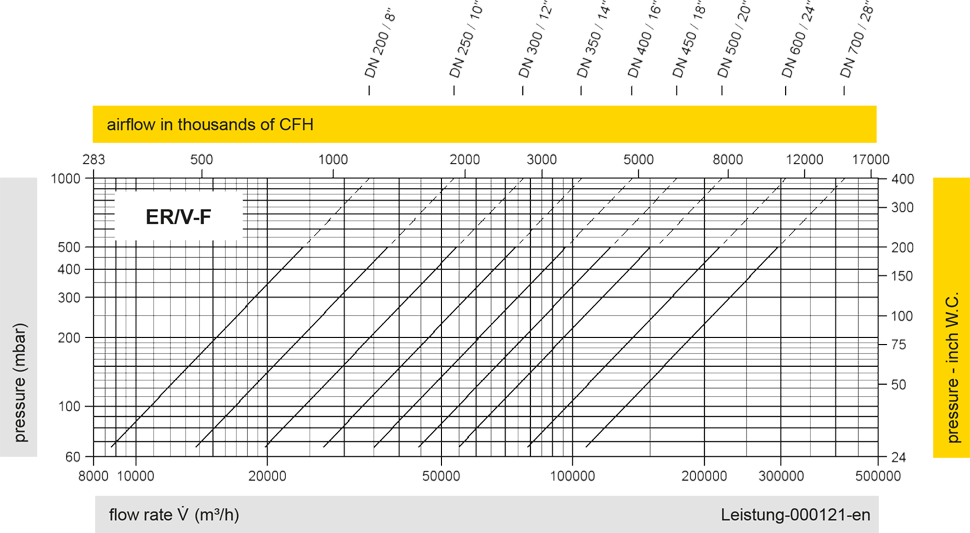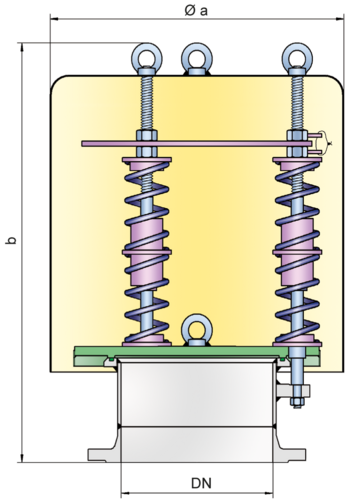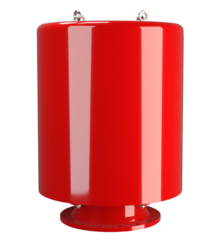ER/V-F
Pressure Relief Valve
- 10% technology for minimum pressure increase up to full lift
- excellent tightness resulting in lowest possible product losses and reduced environmental pollution
- set pressure close to opening pressure for optimum pressure maintenance in the system
- high flow capacity
- valve pallet is guided inside the housing to protect against harsh weather conditions
- can be used in explosion hazardous areas
- sturdy housing design
- spring-loaded for high set pressures
- best technology for API tanks
Function and Description
The ER/V-F type PROTEGO® valve is a highly developed emergency pressure relief valve with high flow capacity. It is primarily used as a device for emergency pressure relief for storage tanks, containers, silos, and process engineering equipment. It offers reliable protection against overpressure and prevents excessive product vapor loss close to the set pressure. It is designed to release particularly large amounts to prevent the vessel from rupturing in an emergency case. The springloading allows for higher set pressures than those with the ER-V-LP, ER/V, or ER/VH.
The device will start to open as soon as the set pressure is reached and only requires 10% overpressure to reach full lift. Continuous investments in and a commitment to research and development have allowed PROTEGO® to develop a low pressure valve which has the same opening characteristic as a high pressure safety relief valve. This “full lift type” technology allows the valve to be set at just 10% below the maximum allowable working pressure of the tank and still safely vent the required mass flow.
Due to the highly developed manufacturing technology, the tank pressure is maintained up to the set pressure with a tightness that is far superior to the conventional standard. This feature is achieved by valve seats made of high-grade steel with an inserted O-ring seal, a precisely lapped valve pallet, and a sturdy housing design. After the excess pressure is released, the valve re-seats and provides a tight seal again.
Dimensions
To select the nominal size (DN), use the flow capacity chart on the following page
| DN | 200 / 8" | 250 / 10" | 300 / 12" | 350 / 14" | 400 / 16" | 450 / 18" | 500 / 20" | 600 / 24" | 700 / 28" |
| a | 465 / 18.31 | 550 / 21.65 | 650 / 25.59 | 650 / 25.59 | 800 / 31.50 | 800 / 31.50 | 1000 / 39.37 | 1000 / 39.37 | 1200 / 47.24 |
| b | 860 / 33.86 | 860 / 33.86 | 1170 / 46.06 | 1170 / 46.06 | 1150 / 45.28 | 1175 / 46.26 | 1430 / 56.30 | 1425 / 56.10 | 1690 / 66.54 |
| (≤370 mbar) | (≤240 mbar) | (≤240 mbar) | (≤270 mbar) | (≤220 mbar) | (≤170 mbar) | (≤130 mbar) | (≤140 mbar) | (≤140 mbar) | |
| (≤148 inchW.C.) | (≤96 inchW.C.) | (≤96 inchW.C.) | (≤108 inchW.C.) | (≤88 inchW.C.) | (≤68 inchW.C.) | (≤52 inchW.C.) | (≤56 inchW.C.) | (≤56 inchW.C.) | |
| b | 980 / 38.58 | 980 / 38.58 | 1490 / 58.66 | 1490 / 58.66 | 1490 / 58.66 | 1515 / 59.65 | 1660 / 65.35 | 1655 / 65.16 | 1910 / 75.20 |
| (>370 mbar) | (>240 mbar) | (>240 mbar) | (>270 mbar) | (>220 mbar) | (>170 mbar) | (>130 mbar) | (>140 mbar) | (>140 mbar) | |
| (>148 inchW.C.) | (≤96 inchW.C.) | (≤96 inchW.C.) | (≤108 inchW.C.) | (≤88 inchW.C.) | (≤68 inchW.C.) | (≤52 inchW.C.) | (≤56 inchW.C.) | (≤56 inchW.C.) |
Material selection
| Design | A | B |
| Housing | Steel | Stainless Steel |
| Valve seat | Stainless Steel | Stainless Steel |
| Valve pallet | Stainless Steel or Steel-Stainless Steel | Stainless Steel |
| Sealing | FPM | FPM |
| Weight | Steel | Stainless Steel |
Flange connection type
| EN 1092-1; Form B1 |
| ASME B16.5 CL 150 R.F. |
Design Types and Specifications
The valve pallet is spring-loaded. Lower pressures are achieved with the ER-V-LP, ER/V and ER/VH designs.
Pressure valve in basic design | ER/V-F |
Additional special devices available upon request.
Settings
| >+60 mbar | +500 mbar | ||
| >+24 inch W.C. | +200 inch W.C. |
Flow Capacity Chart

The flow capacity charts have been determined with a calibrated and TÜV certified flow capacity test rig. Volume flow V in (m³/h) and CFH refer to the standard reference conditions of air ISO 6358 (20°C, 1bar). For conversion to other densities and temperatures refer to Sec. 1: “Technical Fundamentals”.

